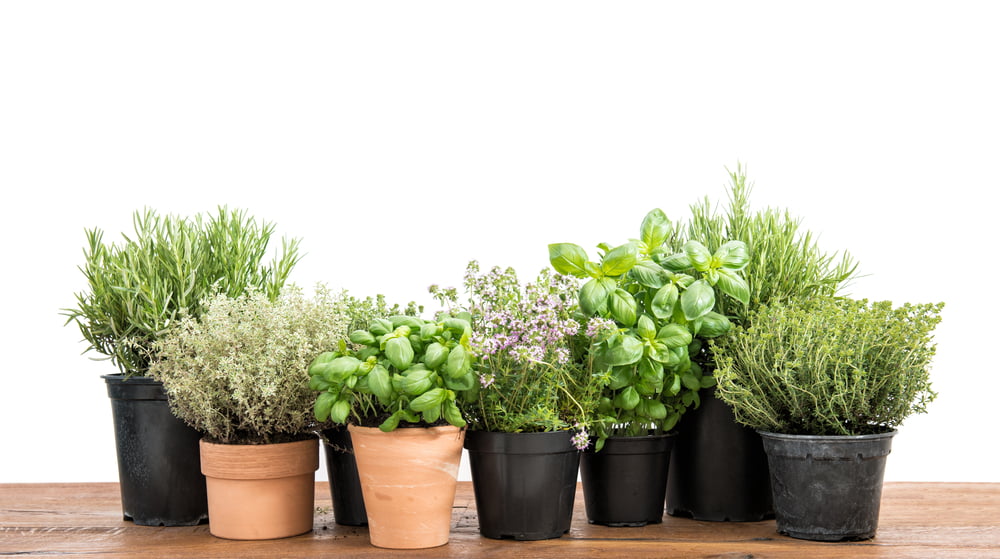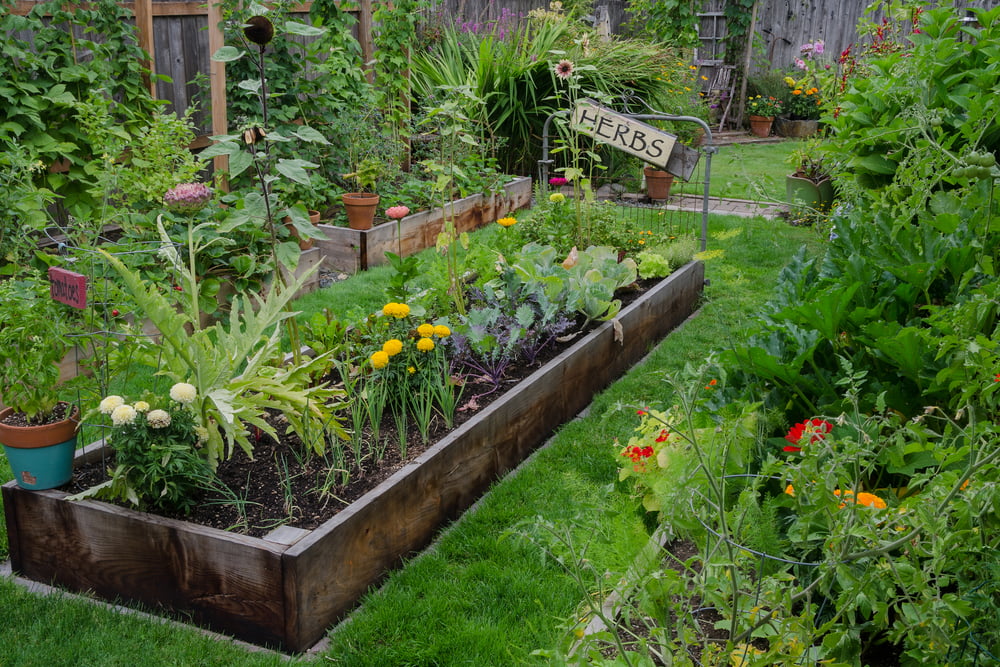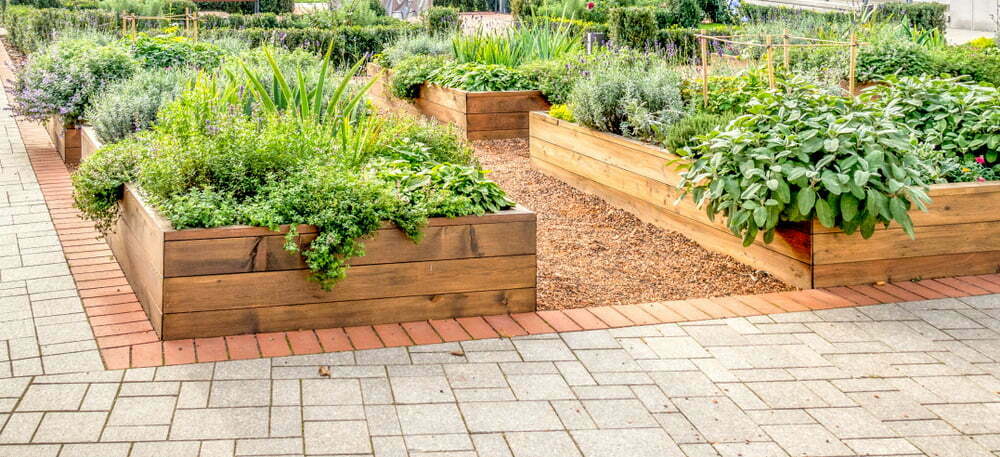In this Article
You’d be hard put to come up with a reason why not to grow herbs – these resilient little plants bring a myriad of benefits to the garden, look great, and also happen to taste delicious too! A carefully-created herb garden is a wonderful asset to any garden, creating a beautiful focal spot that attracts beneficial insects and pollinators.
But did you know that not all herbs like to be grown together? Like all plants, herbs have varying likes and dislikes when it comes to location and soil conditions, and putting all your herbs in the same spot inevitably means that some will fail to thrive. If you’re planning a new herb garden or revamping your growing space, follow our guide to what herbs to plant together for guaranteed success.
What herbs to plant together
Broadly speaking, herbs can be split into two distinct groups that share similar preferences in terms of planting position. The first group, mainly woody-stemmed Mediterranean perennial herbs, like plenty of sun and well-drained sandy soil with low levels of nutrients. The second, mostly soft-stemmed leafy herb varieties, require higher levels of water and nutrients and can tolerate partial shade. Some herbaceous plants are tolerant of variable growing conditions and can be added to either group.
This means that it is not a good idea to grow all herbs in the same location – basil and coriander will quickly bolt in full sun, while thyme and rosemary will struggle to grow in a shady spot. There are ways around this that allow all herbs to be grown together, and we’ll have more on this later! First, let’s look at which herbs will thrive when grown together.
Herbs to plant together in full sun
As mentioned above, the main sun-worshipping herbs tend to come from the Mediterranean. These are found growing wild on sparse, rocky outcrops and can survive with very low levels of moisture even during intense heat waves. Commonly grown Mediterranean herbs include thyme, rosemary, sage, marjoram, and oregano, and these can all be planted together.
Other herbs that grow well in full sun are basil, chives, parsley, and lemon balm. These all prefer moister soil conditions to the woody perennial herbs listed above and can cope with small amounts of shade during the day. Basil and parsley also tend to bolt during periods of hot weather, so moving them into the shade can help to prolong the harvest period.
Herbs to plant together in partial shade
Chervil, coriander, lovage, mint, sorrel, and tarragon will all thrive in a shady spot of the garden, provided they get at least a couple of hours direct sunlight every day. Remember that mint can be quite invasive, so keep this in a separate container from other herbs in this group.

Herbs to plant together in pots
Growing herbs in pots? Here are some great suggestions for herbs that love to grow together:
- Parsley and chives will enjoy the shade produced by a taller sage plant.
- Rosemary and thyme both thrive in sandy soil in full sun, making them ideal companions.
- Lemon balm provides great ground cover for herbs that love moist soil such as basil and coriander.
- Chamomile, hyssop, and lavender can be planted together to create a wonderfully aromatic herbaceous trio.
- While mint is not normally planted with other herbs, growing different types of mint together creates an interesting variety of colours, textures, and aromas.
Best herbs to grow together in hanging baskets
Even if you’ve got very little garden space, a hanging basket of herbs is an attractive feature that can also meet all your culinary needs. A great combination is trailing (prostrate) rosemary with thyme and sage, all of which thrive in full sun. Another option is a hanging basket in a partially shaded area containing basil, parsley, chives, and coriander.
Best herbs to grow together indoors
Two of the most popular herbs to grow on kitchen windowsills are basil and coriander. These fast-growing annual herbs will produce an abundance of leafy growth in a warm sunny spot, and repeated sowings every two or three weeks will give a continuous harvest of fragrant leaves all year round.

Which herbs do not grow well together?
As well as having differing preferences in terms of growing conditions, some herbs just don’t like being planted together. Three herbs that should be kept away from your main herb garden or vegetable plot are fennel, dill, and rue, all of which have allelopathic properties. This means that they emit compounds that repel and even stunt the growth of other plants.
Other problematic herbs that should be grown in individual pots are any from the mint family – spearmint, peppermint, apple mint, chocolate mint, and many more. Mint sends out thick creeping roots that spread rapidly, swamping any other plant in its way. Keep mint plants restricted to a container or planter, removing excess growth to prevent them from taking root in the surrounding area.
Herb planting schemes
So, you want to plant all your herbs in the same area – is this possible? Yes, definitely! By getting clever and creative with your garden design, it is perfectly feasible to grow all your favourite herbs together.

One of the best herb planting schemes is the classic herb spiral. Rocks or bricks are used to build a spiral structure that rises upwards from the ground, creating different planting zones. Sun-worshipping Mediterranean herbs will thrive in the higher well-drained areas, while leafy herbs will appreciate the partial shade of the lower levels. It is also possible to adjust the soil quality in different zones of the spiral to suit the individual needs of your plants.
Similar results to the herb spiral can be created by using different-sized containers and pots, positioning them according to the preference of each plant. Alternatively, get creative by upcycling old shelving units, ladders, or wooden pallets to make a tiered herb planter. Leafy herbs benefit from the shady lower areas, and sun-loving herbs can bask in the sun at the top.

